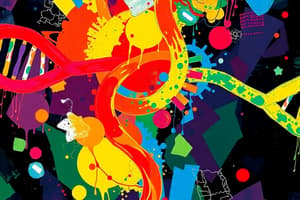Podcast
Questions and Answers
What is a nucleic acid and what are its components?
What is a nucleic acid and what are its components?
A macromolecule composed of nucleotide monomers used by cells to store or transmit hereditary information, including ribonucleic acid and deoxyribonucleic acid. Components are (1) a phosphate group, (2) a five-carbon sugar, and (3) a nitrogenous base.
Phosphate group and nitrogenous base are bonded to the sugar molecule.
Phosphate group and nitrogenous base are bonded to the sugar molecule.
True (A)
Ribonucleotides are monomers of RNA, have ribose as their sugar, and have an -OH group bonded to the 1' carbon.
Ribonucleotides are monomers of RNA, have ribose as their sugar, and have an -OH group bonded to the 1' carbon.
False (B)
Describe deoxyribonucleotides.
Describe deoxyribonucleotides.
Ribose and deoxyribose have an -OH group bonded to the 3' carbon.
Ribose and deoxyribose have an -OH group bonded to the 3' carbon.
Describe the two groups of nitrogenous bases.
Describe the two groups of nitrogenous bases.
Nucleic acids polymerize via?
Nucleic acids polymerize via?
Phosphodiester linkage occurs between a ____________ on 5′ carbon of one nucleotide and ____________ on the 3′ carbon of another.
Phosphodiester linkage occurs between a ____________ on 5′ carbon of one nucleotide and ____________ on the 3′ carbon of another.
Phosphodiester linkages form a ____________.
Phosphodiester linkages form a ____________.
Which of the following statements about James Watson and Francis Crick's findings is correct? (Select all that apply)
Which of the following statements about James Watson and Francis Crick's findings is correct? (Select all that apply)
Describe the structure of DNA.
Describe the structure of DNA.
What is the significance of Watson and Crick's model?
What is the significance of Watson and Crick's model?
What are the three steps of DNA replication?
What are the three steps of DNA replication?
Explain how DNA's double helix is highly structured.
Explain how DNA's double helix is highly structured.
Describe the primary structure of RNA.
Describe the primary structure of RNA.
RNA's secondary structure results from complementary base pairing: A with ___; G with __.
RNA's secondary structure results from complementary base pairing: A with ___; G with __.
Bases of RNA typically form hydrogen bonds with complementary bases on the?
Bases of RNA typically form hydrogen bonds with complementary bases on the?
RNA strand folds over, forming a ____________.
RNA strand folds over, forming a ____________.
Two sugar-phosphate strands are ____________.
Two sugar-phosphate strands are ____________.
Describe RNA's versatility.
Describe RNA's versatility.
A certain DNA molecule is determined to have a guanine content of 40%. What percentage of uracil will be in the RNA synthesized from this DNA?
A certain DNA molecule is determined to have a guanine content of 40%. What percentage of uracil will be in the RNA synthesized from this DNA?
What determines the primary structure of RNA?
What determines the primary structure of RNA?
Provide the complementary strand for: 3' ATTTGGCC 5'.
Provide the complementary strand for: 3' ATTTGGCC 5'.
Flashcards are hidden until you start studying
Study Notes
Nucleic Acids
- Nucleic acids are macromolecules made from nucleotide monomers, crucial for storing and transmitting hereditary information.
- Key types include ribonucleic acid (RNA) and deoxyribonucleic acid (DNA).
- Nucleotides consist of three components: a phosphate group, a five-carbon sugar, and a nitrogenous base.
Sugar Molecules
- Both phosphate groups and nitrogenous bases are bonded to the sugar molecule.
- Ribose in RNA includes an -OH group bonded to the 2' carbon, while deoxyribose, lacking oxygen, includes a sugar that differs at the 2' carbon.
Nitrogenous Bases
- Nitrogenous bases are categorized into purines (adenine, guanine) and pyrimidines (cytosine, uracil, thymine).
- RNA contains uracil instead of thymine, found in DNA.
Polymerization and Linkages
- Nucleic acids polymerize through phosphodiester linkages that connect the 5' phosphate group of one nucleotide to the 3' hydroxyl group of another.
- This linkage creates a sugar-phosphate backbone, which has directional properties.
Structure of DNA
- DNA has a primary structure of linked deoxyribonucleotides, a secondary structure of an antiparallel double helix formed by hydrogen bonds, and a tertiary structure with supercoiling.
- DNA is stable and effectively encodes genetic information through base sequences.
Watson and Crick Model
- Watson and Crick identified that DNA is composed of two antiparallel strands forming a double helix with specific base pairing (A-T and C-G).
- Their discovery explained the ratios of purines to pyrimidines, noted by Chargaff.
DNA Replication
- DNA replication involves the separation of strands, base pairing with free nucleotides, and the formation of complementary strands.
- The process ensures the production of two identical daughter molecules.
RNA Structure and Function
- RNA has a primary structure of linked ribonucleotides, featuring ribose sugar and nitrogenous bases A, U, G, and C.
- RNA can fold into complex shapes, allowing it to perform diverse functions, such as messenger RNA (mRNA) in protein synthesis.
Secondary and Tertiary Structures of RNA
- RNA's secondary structure arises from base pairing (A-U, C-G) within the same strand, leading to hairpin loops and additional stabilizations.
- RNA strands are also antiparallel, facilitating intricate folding patterns.
RNA Versatility
- RNA is versatile, capable of various functions beyond genetic coding, including acting as a messenger, catalyst, and structural component within cells.
Complementary Base Pairing
- For a DNA sequence with a guanine content of 40%, the corresponding RNA will contain 10% uracil, following base pairing rules.
- The primary structure of RNA is determined by the sequence of ribonucleotides.
Complementary Strands
- Given the DNA sequence 3' ATTTGGCC 5', the complementary strand would be 5' TAAACCGG 3'.
Studying That Suits You
Use AI to generate personalized quizzes and flashcards to suit your learning preferences.



